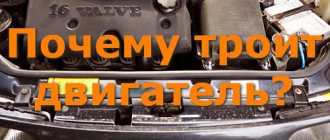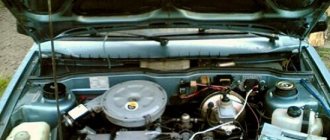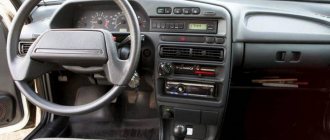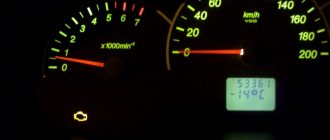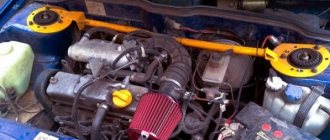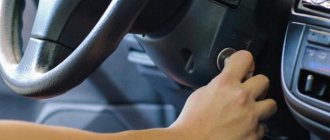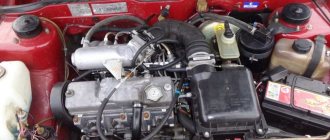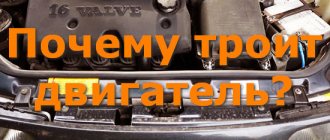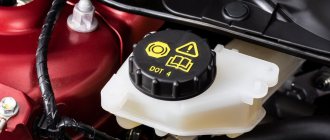The engine heats up and starts to stall: why does this happen?
Almost every car enthusiast sooner or later encounters such a fairly common malfunction of the internal combustion engine, when the engine stalls. As a rule, in certain situations the engine stalls when hot or only when cold, and tripping can also occur constantly (regardless of the temperature of the power unit, operating mode, load level, etc.).
In short, engine tripping means that one or more cylinders are not firing, and there can be several reasons for such a malfunction. In this article we will talk about why the engine stalls after warming up, how the malfunction can be diagnosed, and what signs help to accurately identify the problem.
The engine stalls when hot: causes and common faults
Let's start with the main features. Often, a cold engine starts quite normally, but then begins to stall after partial warming up or completely reaching operating temperatures. In this case, tripping can occur both at idle and under load (while driving).
- You should start by checking the control system (ECM) and the engine power system. It is recommended to immediately carry out computer diagnostics and check the condition of the injector and injectors.
In any case, incorrect readings or malfunctions of sensors (lambda probe, temperature sensor, mass air flow sensor, etc.) and actuators can cause a hot engine to fail. Based on incorrect readings, the ECU may well over-enrich the working fuel-air mixture and flood the spark plugs.
- Next you need to move on to the spark plugs. At the initial stage, you should remove the spark plug high-voltage wires and unscrew the spark plugs from the BC. Next, a visual inspection of their contacts and insulators is carried out. Normally, candles should be dry, grayish in color, without a heavy layer of soot.
If the spark plug is wet and/or oily, then it is quite obvious that too much engine oil is entering the combustion chamber or the fuel is not being burned in the cylinder. In any case, a wet spark plug does not allow the cylinder to operate normally. Let us add that often both causes are often present simultaneously or are a consequence of each other.
If all the spark plugs are wet, you should check the oil level in the internal combustion engine. When the level is elevated (often as a result of overflow), the oil pressure in the lubrication system after the engine warms up exceeds the norm, excess lubricant penetrates the combustion chamber and contaminates the spark plugs. The result is a weak spark.
You also need to check the crankcase ventilation system. For example, the breather hose may become kinked, contamination may occur, etc. The main thing is that problems with this system also lead to pressure rising and excess oil entering the cylinders. If the hot vibration disappears after pumping out excess oil and cleaning the crankcase ventilation system, we can talk about a successful solution to the problem.
If this does not help, the spark plugs themselves will require increased attention. It is likely that even if the spark plugs have recently been changed, they will turn out to be incorrectly selected for the engine in terms of heat rating and will be “cold”; also, the spark plugs may simply fail or the product will be defective. To check, you need a kit that is known to be working (it is better if the spark plugs were removed from another car). If the engine does not start in these sections after warming up, then the spark plugs need to be replaced.
If it turns out that the dry spark plug in the cylinder has become wet, then it is worth checking the high-voltage ignition wire of a particular cylinder. The wire needs to be replaced with a working one. Also note that the problem may not be in the wires. For example, on carburetor internal combustion engines, a common cause of ignition problems is the distributor (ignition distributor).
On injection engines, failures can result from breakdowns of the ignition coils. In the case of a distributor, the device must be disassembled, dried, cleaned the contacts and made the necessary adjustments. If we are talking about an engine with an injector, you can swap the ignition coils and wires. This method allows you to quickly identify a faulty coil.
Tips and tricks
Please note that in order to check the functionality of the ignition system, in some cases it is recommended to check the spark plugs for a spark. It is important to understand that if you simply unscrew the spark plug from the engine, the presence of a noticeable spark on the electrodes is not always a sign of complete service.
At the same time, checking the coils cannot be carried out by diagnostics or various tests, since in many cases the problem can be “floating”, and in the case of the test the readings will be normal. Finally, we note that practical operation identifies problems and malfunctions in the operation of ignition coils as one of the common causes of engine tripping after warming up.
In idle mode and at low speeds, the engine shakes: possible reasons for the unstable operation of the power unit. Self-diagnosis methods.
Why does the engine start to stall and the “check” light up on the dashboard: the main and most common reasons for the engine to stall and the “check” to light up.
For what reasons may misfire of the fuel-air mixture occur in one or more cylinders? Fault diagnosis, recommendations.
After switching to gas, the engine stalls, while running normally on gasoline: the main reasons for this malfunction. Diagnosis of problems, recommendations.
Engine trouble: symptoms. Why does tripping occur and how to find the reason why the motor starts to trip. Checking power, ignition, compression, etc.
Signs of a non-working cylinder (tribbing and vibration) of a diesel engine. Troubleshooting: compression, diesel injectors, glow plugs, injection pump and others.
Source
Answers (2)
There can be many reasons, read about the most common reasons here - https://avtoexperts.ru/article/troit-dvigatel-prichiny/
The first thing to do is check the spark plugs, armored wires, and coils.
check the compression in the cylinders first
Engine 4216 Euro 3 is designed for installation on Gazelle cars. But many motorists have encountered the problem that tripping occurs when operating the engine. What are the reasons for the effect and methods for solving it yourself.
Specifications
Before we begin to directly consider the issue of a malfunction associated with the tripping and blinking “CHECK” on the dashboard of a Gazelle Business car, it is worth considering the technical characteristics of the UMZ 4216 power unit:
| Name | Characteristic |
| Type | Row |
| Fuel | Petrol |
| Injection system | Injector |
| Volume | 2.9 liters (2890 cm3) |
| Power | 123 horsepower |
| Number of cylinders | 4 |
| Cylinder diameter | 100 mm |
| Consumption | 11 liters per 100 km |
| Cooling system | Liquid, forced |
| Econorm | Euro-3 |
On which cars is this problem most common?
The problem with code P0304 can occur on different machines, but there are always statistics on which brands this error occurs more often. Here is a list of some of them:
- Audi (Audi a4, Audi a6, Audi TT)
- BMW (BMW E46)
- Chery (Chery Tiggo)
- Chevrolet (Chevrolet Aveo, Cobalt, Cruz, Silverado, Spark, S-10)
- Chrysler (Chrysler Voyager, PT Cruiser)
- Citroen
- Daewoo (Daewoo Nexia)
- Dodge (Dodge Durango, Caravan, Ram)
- Fiat
- Ford (Ford Mondeo, Mustang, Fiesta, Focus, Fusion, Expedition, F-150)
- Honda (Honda Accord, Odyssey, Pilot, SRV, Civic)
- Hyundai (Hyundai Accent, Getz, Santa Fe, Solaris, Sonata, Tucson, Elantra)
- Jeep (Jeep Wrangler)
- Kia (Kia Rio, Sid, Sorento, Spectra, Sportage, Cerato)
- Lexus (Lexus gx470, rx300)
- Mazda (Mazda 3, Mazda 323, Mazda 6, Mazda cx7)
- Mercedes
- Mitsubishi (Mitsubishi Outlander, Karisma, Lancer, Montero, Pajero, L200)
- Nissan (Nissan Qashqai, Note, Tiida, X-Trail)
- Opel (Opel Astra, Vectra, Vivaro, Zafira, Corsa, Meriva)
- Peugeot (Peugeot Boxer)
- Pontiac (Pontiac Bonneville)
- Renault (Renault Duster, Logan, Megan, Sandero)
- Skoda (Skoda Yeti, Octavia, Superb)
- Ssangyong (Sanyeng Aktion, Kyron)
- Subaru (Subaru Legacy, Forester)
- Suzuki (Suzuki sx4)
- Toyota (Toyota Avensis, Camry, Corolla, Prius)
- Volkswagen (Volkswagen Golf, Jetta, Caddy, Passat, Polo Sedan, Touareg, Tiguan, Transporter)
- VAZ 2105, 2110, 2111, 2112, 2114, 2115
- Volga Cyber
- Gazelle Business, umz 4216
- Lada Granta, Kalina, Niva, Priora
- UAZ Patriot
With fault code P0304, you can sometimes encounter other errors. The most common ones are: P0171, P0202, P0204, P0300, P0301, P0302, P0303, P0305, P0306, P0308, P0354, P0402, P0420, P130A, P1399, C1201.
- Author
- Message
doesn't work well 4216
Post by vova59 » 10/23/2013, 09:15
Re: doesn't work well 4216
Post by putnik51 » 10/23/2013, 09:52
Re: doesn't work well 4216
Post by SergA » 10.23.2013, 19:38
Re: doesn't work well 4216
Post by serdg159 » 10/23/2013, 9:12 pm
Re: doesn't work well 4216
Post by vova59 » 10/24/2013, 08:59
Everything is fine with the tags. Why everyone is talking about the exhaust manifold is not clear. Personally, I drove with a rattling exhaust pipe for 15-20 thousand and did not observe any jerks. (Once upon a time it was summer, season). The consumption was a little higher, but the muffler didn’t shoot, which means you can drive. There cannot be a leak in the exhaust because there is exhaust pressure there.
Malfunction and solutions
The reasons for the occurrence of tripping and blinking “Check” are almost identical for all power units. The root cause may be improper formation of the air-fuel mixture or a breakdown in the ignition system. But, everything is in order.
Poor quality fuel
Low-quality gasoline, or in common parlance - “bad gas”, leads to the fuel supply elements becoming clogged, and the injection system itself forms a lean mixture. To diagnose and troubleshoot the problem, it is necessary to test the injectors. It is better to carry out this entire operation on a special stand. If it turns out that the elements are clogged, then we can say that the vehicle was operated on low-quality fuel.
Another reason could be a clogged fuel filter, which is recommended to be changed every 20,000 km. Also, it is worth examining the performance of the fuel pump, which may fail.
Ignition system
Breakdowns in the ignition system, namely malfunction of spark plugs, high-voltage wires and ignition coils, can lead to a tripping effect. So, you need to unscrew the spark plugs and inspect them for defects. Also, using a simple tester, measure the resistance of the high-voltage wires, which is 5 ohms.
Air supply
The formation of the air-fuel mixture is influenced by the state of the air supply. A clogged air filter element or throttle valve can cause a rich mixture, which can cause a tripping effect. To eliminate the malfunction, it is necessary to dismantle and inspect the elements.
If the air filter is clogged, it is recommended to replace it, but the throttle valve must be cleaned with a special product or liquid for cleaning carburetors.
Software problem
Repeatedly, the cause of the tripping and blinking “Check” is a malfunction of one of the sensors or accumulated errors inside the electronic engine control unit. So, it is necessary to diagnose the condition of the elements and replace damaged ones.
ECU diagnostics
In order to understand which of the sensors or components affected the unstable operation of the engine, it is worth conducting a comprehensive diagnosis of the on-board computer. This requires an OBD II cable, a tablet and laptop, and software.
It is recommended to turn to professionals for help, who will quickly and efficiently perform diagnostic operations and fix the problem.
Deciphering error codes
If the car owner nevertheless decides to fix the problem on his own, then he will need to decipher the error codes that will appear on the diagnostic computer screen. So, let's look at all the error codes and their interpretation for the UMZ 4216 engine:
| DTC | Description |
| P0105 | Incorrect air pressure sensor signal |
| P0107 | Low signal level from air pressure sensor |
| P0108 | High signal level from the air pressure sensor, |
| P0122 | Low signal level from throttle position sensor (1 track) |
| P0123 | High signal level from the throttle position sensor (1 track) |
| P0112 | Low signal level from air temperature sensor |
| P0113 | High signal level from the air temperature sensor |
| P0115 | Incorrect signal from the coolant temperature sensor |
| P0117 | Low signal level from the coolant temperature sensor |
| P0118 | High signal level from the coolant temperature sensor |
| P0130 | No activity of oxygen sensor No. 1 |
| P0131 | Low signal level from oxygen sensor No. 1 |
| P0132 | High signal level from oxygen sensor No. 1 |
| P0133 | Oxygen Sensor #1 - Slow Response |
| P0135 | Open circuit of oxygen sensor heater No. 1 |
| No. 1 oxygen sensor heater circuit short to ground | |
| Short to power in the oxygen sensor heater circuit No. 1 | |
| P0137 | Low signal level from oxygen sensor No. 2 |
| P0138 | High signal level from oxygen sensor No. 2 |
| P0141 | Open circuit of oxygen sensor heater No. 2 |
| Short to ground circuit of the heater of the oxygen sensor Lg "2 | |
| Short to power in the oxygen sensor heater circuit No. 2 | |
| P0201 | Broken injector of cylinder 1 |
| Ground fault in cylinder 1 injector | |
| Short circuit to power supply of injector 1 cylinder | |
| P0202 | Broken injector of cylinder 2 |
| Injector 2 cylinder short to ground | |
| Short circuit to power supply of injector 2 cylinders | |
| P0203 | Broken injector cylinder 3 |
| Injector 3 cylinder ground short | |
| Short circuit to power supply of injector 3 cylinders | |
| P0204 | Broken injector 4 cylinders |
| Injector 4 cylinder ground short | |
| Short circuit to power injector 4 cylinders | |
| P0217 | Engine temperature is above the maximum permissible |
| P0219 | Engine speed is above the maximum permissible |
| P0221 | Range limit of the difference between 1 and 2 tracks of TPS |
| P0222 | Low signal level from throttle position sensor (2 track) j |
| P0223 | High signal level from the throttle position sensor (2 track) j |
| Open circuit of the fuel relay | |
| P0230 | Fuel relay primary circuit short to ground |
| Fuel relay primary circuit short to power | |
| P0301 | Misfire in cylinder 1 |
| P0302 | Misfire in cylinder 2 |
| P0303 | Misfire in cylinder 3 |
| P0304 | Misfire in cylinder 4 |
| P0327 | Low signal level from knock sensor |
| P0339 | HF Sync Sensor Synchronization Error |
| P0335 | HF synchronization sensor break |
| P0341 | Phase sensor synchronization error |
| P0351 | Broken ignition coil 1 |
| P0352 | Broken ignition coil 2 |
| P0420 | Low efficiency of the exhaust catalyst |
| Open circuit of the canister purge valve | |
| P0443 | Short circuit to ground in the canister purge valve circuit |
| Short circuit to power in the canister purge valve circuit | |
| Cooling fan relay primary circuit open | |
| P0480 | Cooling fan relay primary circuit short to ground |
| Cooling fan relay primary circuit short to power | |
| P0501 | Broken vehicle speed sensor |
| • | Idle air control malfunction | |
| P0505 | Open circuit of the idle speed regulator |
| Idle air control circuit short to power | |
| P0563 | High on-board voltage |
| P0562 | Low on-board voltage |
| P0603 | Control unit EEPROM error |
| P0604 | Control unit external RAM error |
| P0605 | Error in the external ROM of the control unit (ROM1) |
| P0606 | Control unit initialization error |
| Open circuit of the CHECK ENGINE lamp | |
| P0650 | Short circuit to ground in the CHECK ENGINE lamp circuit |
| Short to power in the CHECK ENGINE lamp circuit | |
| P1107 | Low signal level from the barocorrection sensor |
| P1108 | High signal level from the barocorrection sensor |
| P1122 | Low signal level from the accelerator pedal position sensor (1 track) |
| P1123 | High signal level from the accelerator pedal position sensor (1 track) |
| P1221 | Range limit of the difference between 1 and 2 accelerator pedal tracks |
| R.1222 | Low signal level from the accelerator pedal position sensor (track 2) |
| P1223 | High signal level from the accelerator pedal position sensor (track 2) |
| . Open circuit of the main relay primary circuit | |
| P1230 | Main relay primary circuit short to ground |
| Short to power in the primary circuit of the main relay | |
| Break in the primary circuit of the starter interlock relay | |
| P1330 | Starter interlock relay primary circuit short to ground |
| Short to power in the primary circuit of the starter interlock relay | |
| P1351 | Ignition coil 1 short circuit |
| P1352 | Ignition coil 2 short circuit |
| Open air conditioner relay primary circuit | |
| P1530 | Air conditioner relay primary circuit short to ground |
| Air conditioner relay primary circuit short to power | |
| P1570 | Open circuit of communication with immobilizer |
| P1606 | Low signal level from rough road sensor |
| P1607 | High signal level from rough road sensor |
| P1612 | Control unit reset error |
Misfire Gazelle Business 4216 reason
Are misfires detected by the lambda? Maybe a snag instead of a lambda?
most likely not, most often when the cylinders are turned off, the data from the LZ does not change. I don’t understand the algorithm of operation of this motor and this ECU at all, it contradicts any logic
